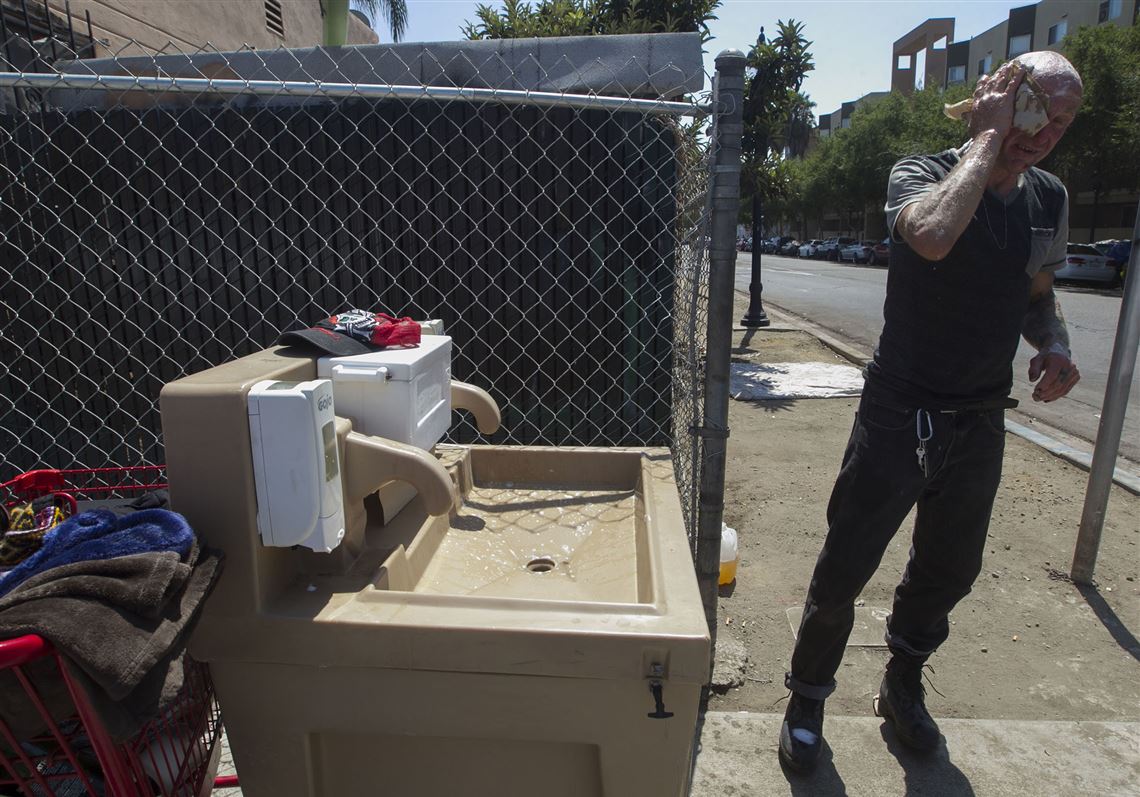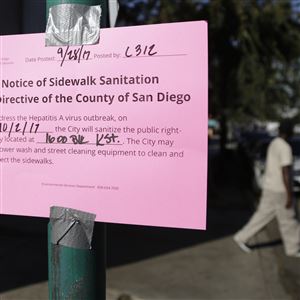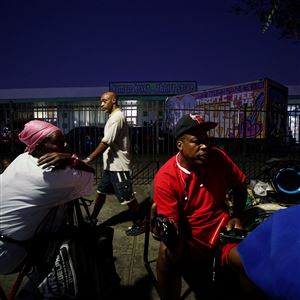SAN DIEGO — Finger-pointing started Monday over what appears to be a delayed response to the deadly hepatitis A outbreak ravaging San Diego County, as public records to and from city and county officials began to be released.
In one email from June, an officer at St. Vincent de Paul’s charity told county leaders that the city flatly refused to install portable toilets and sinks to help control the spread of the virus, which has infected nearly 450 people in recent months and killed 16.
“From my understanding, the city of San Diego has declined an opportunity to put portable toilets/wash stations around the city because it wasn’t so long ago they were fighting other kinds of outbreaks by virtue of the availability of portable toilets,” Ruth Bruland wrote June 30.
The city has a long history of warnings by the grand jury and others over the need for restrooms downtown, where a growing homeless population has had to use other means to relieve themselves — contributing to the current sanitation and health crisis. A concern that restrooms attract drugs and prostitution has been one impediment.
The St. Vincent de Paul email was released by county spokesman Michael Workman after The San Diego Union-Tribune asked him to respond to a batch of other emails released by the city under a California Public Records Act request.
Those communications, hundreds of exchanges to and from city and county public officials, show the two agencies discussing a multitude of responses to the public health threat and not implementing them broadly for months — even as the death toll mounted.
Bruland did not immediately respond to questions about her email to county officials. According to Workman, city officials early in the crisis did not act on certain matters as the preventable outbreak of the liver infection hepatitis A grew more deadly by the month.
Many of the measures proposed involved better hygiene to avoid spread of the disease, which can occur when tiny amounts of fecal matter are transmitted and ingested.
“May 4 we proposed the wash stations and city said no,” Workman said Monday. “Two weeks later we offered to pay for them, still no.”
“June 28 they said they’ll consider a permit process but want us to pilot first on our properties,” he said. “(We) placed one in July at Rosecrans,” where the county has offices for the Health and Human Services Agency.
Greg Block, a spokesman for Mayor Kevin Faulconer, said the city did not turn away wash stations.
“We never had any issues with the installation of hand washing stations, except they had to be self-contained and in compliance with (permits),” he said.
Block said the city deferred in responding to the outbreak because the county has public-health experience the city lacks.
“The county is our public health agency,” Block said. “They have the expertise on public health matters that the city does not. As a result, we take our direction on public health issues from them.”
Block said the city’s reluctance to embrace new bathrooms downtown and in other areas where the outbreak is most concentrated stems from previous experiences with public restrooms that have been well-documented.
“We have had issues with vandalism and illegal activities, causing complaints from residents and business owners, leading many of them to be removed,” Block said. “The restrooms we have installed recently all have 24 hour security.”
The city and county installed 40 or more temporary sinks in at-risk communities earlier this month. Records show discussion of the measure started as far back as June.
“We are waiting for the final description of what you envision the ‘handwashing’ stations will look like (e.g. specifications) and locations that you may want to utilize,” Stacey LoMedico, the city’s assistant chief operating officer, wrote to Deputy Public Health Officer Sayone Thihalolipavan in late June.
“I have our development services department staff on standby so they can provide us the requirements (e.g. permit(s)) that may be needed to install in the public (right-of-way),” she added.
Thihalolipavan replied just 10 minutes later, saying the idea was still in development.
“It is only in planning phase right now and once we get with the contractor and get those details we can definitely pass them along of course,” the county public health official wrote back.
In another email exchange this spring, city officials were asked for information about suspected hepatitis A patients treated by San Diego Fire-Rescue teams but held off until the county could provide a list of specific names.
“I wanted to check on status of the request from (county Health and Human Services Agency) re: EMS patients who may have contracted hepatitis A,” Dr. James Dunford, the city emergency medical services director, wrote to two fire officials May 31. “Were we able to provide a report to Dr. (Wilma) Wooten?”
Deputy Fire Chief Gina La Mantia replied three hours later, telling Dunford that another city worker was awaiting the list from the county of specific patients the county was seeking data about.
Block said Monday that the city responded to and acted on all directives from the county immediately.
“On May 23 fire department staff reached out to county health letting them know they needed (specific) patient information,” Block said. “The info was provided to the fire department on June 5. We responded on June 6.”
Top officials from the city and county also spent weeks discussing something as simple as posters for a public-awareness campaign.
The outbreak was identified in March, the posters were first discussed in June and they weren’t deployed until August.
By that time, 10 people were dead and more than 200 had been hospitalized.
“The ad campaign started this week and we have some posters printed,” Thihalolipavan informed LoMedico on Aug. 17. “I’m bringing some today to regional task force meeting where I’m presenting.”
The county public health official asked how many posters the city wanted and where they should be delivered.
The city official wrote back suggesting 150 posters to start. She said the city would display them at city recreation centers, libraries and other public spaces.
“I believe it is the same poster/flyer that was shared with me a few weeks ago,” LoMedico said, referencing the time that had passed since the project began.
By late August, as hepatitis A cases began generating more headlines, the city and county committed to installing 40 or more temporary sinks in places where at-risk people congregate. There was further discussion of where they would be placed and who would be responsible for maintaining them.
“Please attach Exhibits A and B to the document and have it executed (see attached),” San Diego engineering official Greg Hopkins told the county Aug. 30. “Please make sure to add the additional sheet to Exhibit A that indicates the maintenance criteria and send it back to me.”
The next day, Wooten, the county public health officer, told LoMedico that the list of places where the sinks were scheduled to be installed had been completed but that some changes may still be made.
“Teams went out to assess the sites, some locations will be removed and others will be added,” Wooten wrote. “We will provide you a full list tomorrow morning after our Hep A meeting.”
LoMedico alerted a number of city officials, including Gerry Braun and Mary Nuesca from the City Attorney’s Office, which apparently was asked to sign off on the specific placements on city property.
“Making sure you are aware of the change of plans by county,” LoMedico wrote. “Gerry/ Mary — you are on here as we discussed that we need a letter/ approval for them to put into the parks/ city property asap. I have yet to hear back on that request.”
Hepatitis A is being spread person-to-person, county health officials said, in large part due to the lack of bathrooms and proper sanitation among the homeless community that lives in makeshift shelters on the streets and alleys downtown.
The San Diego outbreak is easily the worst in the United States since the 1990s.
That’s when a newly developed vaccine helped drive down the number of reported cases from tens of thousands a year to fewer than 1,300 in 2015, the most recent year for which federal statistics are available.
First Published: September 27, 2017, 10:45 p.m.


















